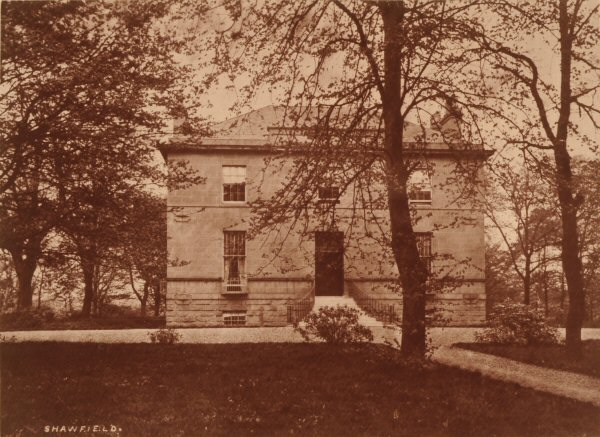

SHAWFIELD is situated on the banks of the Clyde, in the parish of Rutherglen and county of Lanark.
In 1611 Sir Claud Hamilton, second son of Lord Claud Hamilton, who was Commendator of the Abbey of Paisley, and from whom descends the ducal family of Abercorn, had with Janet Hamilton, his spouse, a charter of the lands of Shawfield and others. About the middle of the same century his grandson, Sir James Hamilton, of Manor-Elieston, was in difficulties, and was obliged to sell Shawfield and remove to Ireland.
After being possessed for a short time by different families, Shawfield was acquired in 1707 by Daniel Campbell. (1)
Daniel Campbell of Shawfield is a name well known in Glasgow history. He had made a large fortune, and was, besides Shawfield, proprietor of the valuable estate of Woodhall, in the same county. Moreover, in 1711 he built for his town residence a very handsome edifice in Glasgow, which was known by the name of the "Shawfield Mansion," and which became famous in connection with the "Shawfield Riots" of 1725.
These riots arose from the imposition of a malt tax upon Scotland, which was an extremely unpopular measure, and gave rise to the most vehement opposition in all the large towns, Glasgow in particular. Daniel Campbell was at that time M.P. for the Glasgow district of Burghs, he had voted in favour of this tax, and was in consequence viewed with great disfavour. On the day the tax was to come into operation a mob took possession of the city, prevented the officers of excise from collecting the duty, and proceeding to the Shawfield Mansion completely demolished the interior of it and destroyed all its contents. After some days of further rioting order was restored, but not until the military and the mob had come into collision and many lives lost. The Provost and Magistrates were arrested and taken prisoners to Edinburgh, by order of Lord Advocate Forbes, on the ground of having favoured and encouraged the mob, and, by doing so, having been the cause of the death of several of their fellow-citizens, of endangering His Majesty's troops, and of causing the destruction of Shawfield house.
Mr. Campbell, by order of Parliament, received, from the city of Glasgow, about £9,000 as compensation for the damages and expenses caused by this riot. He soon afterwards purchased the island of Islay, and this money received from Glasgow formed a large part of the price paid for it.
On the death of Daniel Campbell his son John Campbell succeeded. He married in 1735 the Lady Henrietta Cunningham, daughter of William, twelfth Earl of Glencairn, and had three sons, of whom Daniel and John died unmarried and Walter succeeded.
Walter Campbell married first, in 1768, Eleanora, daughter of Robert Kerr of Newfield, and had, with other issue, (2) John, who married, in 1796, the Lady Charlotte Campbell, daughter of John, fifth Duke of Argyle, and had, with other issue, Walter Frederick Campbell, who succeeded his grandfather.
Walter Frederick Campbell of Islay was a very well-known man. He was member of Parliament for Argyleshire from 1820 until 1841, and lived in princely style in London and at Islay, but ultimately his fortune was so much impaired that he was obliged to sell all his estates. His son, John Francis Campbell, who is the representative of the Campbells of Shawfield, is a Barrister-at-Law and Groom of the Privy Chamber. (3)
Shawfield was sold by Walter Campbell in 1788, and after being in several hands is now the property of John White, and on part of the estate are placed the great chemical works of his firm, John & James White.
(1) "He was the son of John Campbell, an eminent Notary in Glasgow, whose office was in the then fashionable locality, rejoicing in the euphonious appellation of the Goosedubs." ("Glasgow Past and Present.")
(2) Walter Campbell's family, by his first wife, were, (I.) John, who carried on the line; (II.) Robert of Skipness, who was the father of Colonel Walter Campbell, late of Skipness, author of several interesting works, and for many years in command of the Pensioners in Glasgow; (III.) Walter; (IV.) Colin. By his second wife Mary, daughter of William Nisbet of Dirleton, he had a son who died unmarried, and two daughters, of whom the eldest, Hamilton, married the late Lord Belhaven, and the younger, Mary, married James, fifth Lord Ruthven, whom she survived.
(3) His youngest daughter Castalia Rosalind is the second wife of Earl Granville, the popular leader of the Liberal party in the House of Lords.
Back to Contents